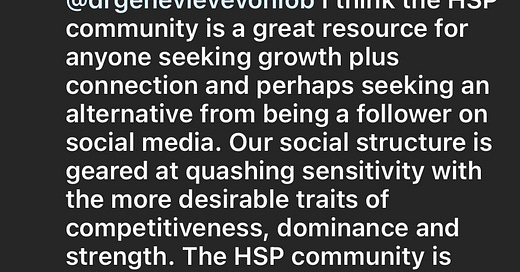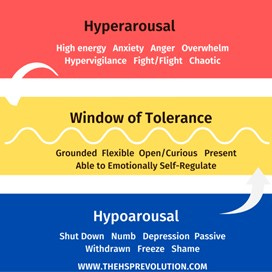Ten Tips For Managing Overstimulation
Simple steps can keep a highly sensitive nervous system calm.
I warmly welcome you to join The HSP Revolution online membership community — where I host two live workshops per month, post daily inspiration, and provide opportunities to share and connect. We’ve just had a great workshop on “Managing Our Energy As HSPs.” I’ll be holding the next workshop on “Living Our Purpose,” on Thursday 9 March at midday GMT. Here’s what members are saying:
Access to this weekly newsletter is now reserved primarily for community members. I will continue to send one edition per month free to all existing subscribers. To continue reading the whole newsletter each week, please do join us in the membership community, and gain access to workshops, daily inspiration and more!
Every month in The HSP Revolution online community, we nominate a topic to focus our workshops, daily dose of inspiration and chat threads.
This month we’re exploring how we can better manage overwhelm as Highly Sensitive People (HSPs).
With our high sensitivity to sensory input, and tendency to experience emotions and thoughts so deeply, it’s very easy for HSPs to become overstimulated — and start to feel edgy and anxious, and like we can’t think straight.
Since we absorb so much, we may feel overwhelmed by situations that the people around us appear to be handling relatively easily, such as ups and downs in relationships; work pressures; social settings, or just spending too much time on screens.
I suspect that many people reading this will know exactly what it feels like when your nervous system and senses become overloaded, and there’s just too much to process.
Here are some of the classic symptoms of overstimulation that I observe in myself and HSPs (who make up about 30 percent of the population) I work with:
Feeling irritable and snappy
Tearful
Restlessness and agitation
Anxiety, worry and rumination
Difficulty concentrating
Brain fog or can’t think clearly
Drained and exhausted
Trouble sleeping
Dissociation (Being disconnected from your body)
Inability to tolerate distracting sounds, such as sirens or drilling
Physical symptoms such as a heart palpitations, sweating
Headaches, migraines, eye strain, back pain, gut or digestive issues
Of course, you don’t need to be an HSP to experience overstimulation, but HSPs tend to hit our limits sooner.
Several community members shared about how they picked up easily on others’ negativity — such as bad moods, judgment or criticism. Others described how clutter and mess; feeling rushed and running late; or loud noises (building work is a particular flashpoint) were triggers for them.
For some, the feeling of being overstimulated can build up gradually over time. For others, it seems to come out of nowhere. There is no one-size-fits-all rule.
I thought I’d share some concepts and practical tips for managing overwhelm that I use in my own life — and I’ve found work with my coaching clients.
I’m delighted to be teaming up with coach and trainer Jules De Vitto to run a Highly Sensitive Person retreat at the gorgeous Quadrangle in Kent, UK, on June 15-18, 2023. Jules and I have worked very hard to make this a great value offering with fantastic food and accommodation — and opportunities to take part in carefully-curated activities — from workshops on high sensitivity, breath work and wild swimming, to ecstatic dance, sound baths and more. All activities are optional and you’ll have plenty of time to relax. Early bird bookings are open until March 31. See you there!
“Window of Tolerance”
One concept I’ve found helpful in dealing with my own feelings of overwhelm is “The Window of Tolerance” — developed by the psychiatrist Dr Daniel Siegel (and shown in the diagram below).
Siegel says that we all have a state of “Optimal Arousal” (shown in yellow) in which we’re able to function and thrive. When we stay within this window, we can learn effectively, play and relate well to ourselves and others.
When our stress levels are too high, however, we go into “Hyperarousal” (shown in red) — an overwhelmed, chaotic state that kicks in when our fight-or-flight response has been triggered.
When our stress levels are too low, by contrast, we can slip into “Hypoarousal” (shown in blue) — we’re shut down, numb, depressed and feel passive and withdrawn (a “freeze” state).
Many factors may influence how easy or difficult we find it to stay within our Window of Tolerance: Significant childhood experiences; our temperament; our support network; our environment and our coping skills.
Since we’re likely to feel strong emotions, or become overwhelmed more easily, we may find as HSPs that our Window of Tolerance seems narrower relative to many of the people around us. That doesn’t mean there’s anything wrong with us — it just means that we need to pay extra attention to our stress levels, so we can minimise the amount of time we spend in the red or blue zone.
I often use the visual metaphor of an inner “bucket” to help HSPs monitor our nervous systems, and check in from time to time to see how regulated we are feeling throughout the day (I also find the bucket image really helpful with my work with Highly Sensitive Children).
Everything we see, hear, smell, notice and experience adds more drops to the bucket. Stressful moments pour more water in. If the bucket gets too full, it starts to overflow — which we might express through an irritable comment; an angry outburst; excessive rumination, or tears.
Once we become aware of our inner bucket, we can make a more conscious choice to take time to empty it at various times throughout the day.
Ten Tips For Staying Calm
Here are some simple ways you can start to empty your bucket:
Close your eyes: Eighty percent of our sensory input comes in through the eyes. Closing your eyes regularly throughout the day for just for few seconds can be very relaxing.
Deep breaths: Deep breathing stimulates the vagus nerve, which is the brake on the body’s stress response. I like a breathing exercise known as “Four-seven-eight.” You inhale through the nostrils for a count of four, hold the breath for a count of seven, and then exhale slowly out though the mouth for a count of eight, then repeat for as long as feels right.
Downtime: Scheduling in unstructured downtime, with plenty of sleep and nothing in the diary, is an essential part of managing our HSP temperaments. This may mean time alone, time in nature, and time away from everyday tasks. This is particularly important if you are an extravert HSP who loves being around people. Dr Elaine Aron, the American psychologist who coined the term HSP, recommends at least two hours a day where your mind is drifting. Going on a well-being retreat in nature — like our HSP retreat in the UK in June – is also a great way of giving yourself a weekend to rest, recharge and recuperate. It’s so important to give yourself this time guilt-free, because you need these breaks to operate effectively.
Give yourself permission to take regular breaks: It can be easy to focus so intently on a work task, that you forget to get up from the computer screen. A change of scene — even if it’s just going to the bathroom to splash your face with cold water or a short walk – can make all the difference. If you’re feeling really on edge, and are at work or with family, let people know that you’re going for a walk to take care of yourself. The hardest part is giving ourselves permission to take a break. In those moments, it’s really helpful to bring awareness to our bodies and recognise that we aren’t actually facing any kind of threat — it’s just that our nervous system has become overstimulated.
Move: Physical activity is one of the best ways to interrupt the body’s stress response. Some examples include putting your favourite music on and having a dance; walks; running; climbing; yoga; Tai chi; kickboxing or cycling. The feeling of moving your body against resistance is one of the most calming types of sensory input you can receive, so even gentle tasks such as gardening or washing the car can be relaxing.
Create: HSPs tend to be naturally creative, so make time to do whether you enjoy – whether it’s art, journalling, fashion, interior design, dancing, embroidery, knitting, music. mindful colouring or anything else that connects you with your creative side.
Reach out for support: No matter how many close friends with have, in our busy world it can be difficult to connect with people when we’re in need of a lift, or a listening ear. One of the reasons that I created The HSP Revolution community is to provide a space where people can connect at any time to receive support, inspiration and encouragement — and share what’s going on for them without fear of judgment.
Create your sanctuary: Our environment is so important for helping our nervous system to feel safe — even a cozy chair, desk or quiet corner can play this role. You can use soothing colours, low lighting, plush pillows and soft blankets — or create a box of things that bring you joy, such as your journals, candle and scents. (Before coaching sessions, I love to put a relaxing lavender aromatherapy blend in my diffuser and listen to a soothing playlist).
Self-compassion: It doesn’t always feel easy, but nurturing yourself and being gentle are so important. Offer yourself the same kindness that you would to a small child or pet. Say to yourself: “I know it’s not easy right now. It’s understandable you’re overwhelmed and anyone would feel this way. You feel tired and drained. You’re not alone. I’m here right with you. What do you need?”
Give yourself time: Sometimes it’s just not possible to do anything when we’re overwhelmed, exhausted and our body has become flooded with stress hormones. Sometimes we have to ride the wave, and remind ourselves — if we can — that this moment won’t last forever. When you come back to a more grounded place, you’ll have more of an idea of what might help you.
All this can sound like a lot to think about — but we have to accept that as HSPs, we’re wired in such a way that means we can get overstimulated very easily. If we accept our temperament, we can manage our days more easily — and avoid feeling overloaded. Because when we’re rested and recharged, HSPs can be some of the most inspiring, creative and intuitive people — and the life and soul of any group.
If you’re keen to learn more about managing your own energy, in the company of others on the same journey, then do consider whether The HSP Revolution membership community might be a good fit for you.
See you next week!








